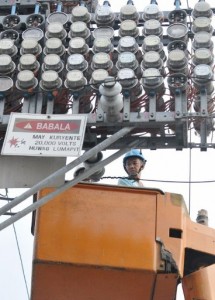
Manila Electric Co. utility workers install electricity metres at a Manila neighborhood in this file photo. Inflation slowed for a fifth month in a row in March on lower utility and transport costs, according to government. AFP PHOTO/JAY DIRECTO
Inflation slowed for a fifth month in a row in March on lower utility and transport costs, but economists still expect the central bank to keep its key policy rate unchanged at a record low to guard against pressures from higher fuel prices.
The consumer price index (CPI) rose 2.6 percent in March from a year earlier, the National Statistics Office said on Wednesday, below the market’s consensus forecast of a 2.8-percent rise and the lowest since September 2009.
Year-to-date inflation is at 3.1 percent, well within the target of 3 to 5 percent.
“The very low [annual] inflation gives us a buffer from the uncertainties in the international oil market,” said Ruperto P. Majuca, assistant director general at the National Economic and Development Authority (Neda). Majuca said Neda was anticipating a “very slight” increase in year-on-year inflation in the coming quarters due to volatile oil prices but the full-year 2012 inflation would stay within target.
Former budget secretary Benjamin E. Diokno of the UP School of Economics also said the mild inflation to date provided some comfort for maintaining the present interest rate policy of the Bangko Sentral ng Pilipinas, but the prices of electricity, power, transport fare and wages should be closely monitored.
“The power crisis in Mindanao needs close monitoring since the immediate solution requires more costly power sources for both firms and households. Abroad, the uncertainty brought about by the Iran situation remains. A countervailing force is that the harsh winter is over and the usual driving season during summer months may be tempered by a slower economy,” Diokno said.
“We will continue to monitor price developments, particularly volatilities in international commodity prices, to see how these would impact domestic price setting,” Bangko Sentral Governor Amando Tetangco said in a mobile text message to reporters. “We will also follow data closely to see how previous policy actions are working through market behavior, to see if any further policy adjustment is needed to ensure continued well-behaved price expectations and action.”
The Philippines imports most of its fuel needs, exposing it to changes in global oil prices.
“In light of upcoming power tariff increases and the threat of a rally in global crude prices, we stick by our view that the benchmark rate will be left unchanged for the year, despite the current subdued inflation environment and growth risks,” said Radhika Rao, economist at Forecast Pte in Singapore.
Last month, Tetangco said inflation was expected to be comfortably within the 3- to 5-percent target range this year and next despite rising oil prices. The central bank has forecast average inflation at 3.1 percent and 3.4 percent in 2012 and 2013, respectively. The BSP cut its main policy rate by a quarter point to a record low 4 percent at a March 1 meeting to help cushion the economy from the impact of a global slowdown. Its next policy review is on April 19.
Most economists in a Reuters poll in March expected the central bank to leave the key overnight borrowing rate unchanged at 4 percent for the rest of the year to boost domestic demand.
But Jun Neri, economist at the Bank of the Philippine Islands, said the central bank should take advantage of slowing inflation and cut rates further.
“The fact that it is below the full-year target and even lower than the February figure [makes it] a golden opportunity for the BSP to ease further, mainly to assure against the risk of slower global and domestic growth,” Neri said. “They seem to be hinting to the markets that they will be neutral on [April 19], but I guess the figure today may have to lead them to reconsider.”
Policymakers elsewhere in Asia have kept monetary policy on hold recently as the global outlook remains uncertain, despite concerns about rising energy prices. With a report from Reuters